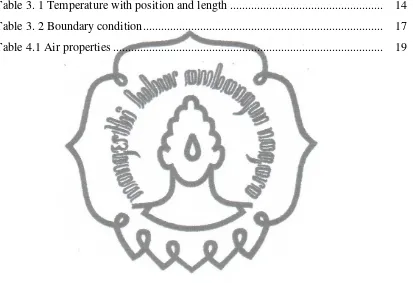commit to user
The Effect of Varying the Distance to Temperature distribution Using ANSYS
CFX
THESIS
Organized to Meet a Part of the Requirements to Achieve
the Master Degree of Mechanical Engineering
By
BASHER H ALSDAI
S951208504
POSTGRADUATE PROGRAM
MECHANICAL ENGINEERING DEPARTMENT
SEBELAS MARET UNIVERSITY
SURAKARTA
commit to user
commit to user
commit to user
iv
ORIGINALITY AND PUBLICATION STATEMENT
I Declare that:
1. Thesis entitledμ “The Effect of Varying the Distance to Temperature
distribution Using ANSYS CFX” is my work and free of plagiarism, and there
is no scientific papers that have been asked by others to obtain academic degrees
and there is no work or opinion ever written or published by another person
except in writing used as a reference in this text and a reference source as well as
mentioned in the bibliography. If at a later proved there is plagiarism in scientific
papers, then I am willing to accept sanctions in accordance with the provisions of
the legislation (Permendiknas No 17, tahun 2010)
2. Publication of some or all of the contents of the thesis or other scientific forums
and permission must include the author and the team as a supervisor. If within at
least one semester (six months after the examination of the thesis) I did not make
the publication in part or entire of this thesis, the Program in Mechanical
Engineering of UNS has the right to publish in a scientific journal published by
Study Program in Mechanical Engineering of UNS. If I violate of the provisions
of this publication, then I am willing to get an academic sanction.
Surakarta, January 2015
commit to user
v
BASHER H ALSDAI, Student Number: S951208504. The Effect of Varying the
Distance to Temperature distribution Using ANSYS CFX. Supervisor I: Dr. Budi
Santoso. Supervisor II: Prof. Dr . Dwi Aries H., ST., MT. Thesis: Mechanical
Engineering Department, Graduate School, Sebelas Maret University.
ABSTRACT
This study was dealt how to solve the problem of analyzing one dimensional
unsteady state heat conduction in semi-infinite rod at constant thermal conductivity.
The problem geometry and meshing were made in ANSYS Workbench. The
mathematically model was applied on the basis of Fourier’s law. The model was
analyzed by ANSYS CFX 12.0 solver. The parameters of the model were employed for
the solution for semi-infinite rod with heat generation sources as well as laminar heat
transfer coefficient, which was h=14.52 W/m2k. The result findings showed that there
is a significant similarity between the experimental and numerical value. The residual
average at x1 distance showed the lowest value with highest coefficient sensitivity,
which was close to the 0 value. Consequently, this study suggests that the usage of
ANSYS CFX 12.0 solver can be used to accomplish the difficulty of analyzing one
dimensional unsteady state heat conduction.
commit to user
vi
PREFACE
I would like to express my greatest appreciation to my supervisors, Dr. Budi
Santoso and Dr. Dwi Aries H., ST., MT. for their guidance, support and
encouragements throughout my entire Master study.
Their meticulous attention to details, incisive but constructive criticisms and
insightful comments have helped me shape the direction of this thesis in the form
presented here, on. I am also thankful to them for their strong supports in other
aspects of life than research. I would also like to convey my gratitude to the head of
mechanical engineering department Dr. techn Suyitno. I deeply appreciate my parents
and my family. Their love and encouragement light up many lonely moments in my
life as a graduate student away from home and have been the source of courage when
I was down. I would like to express my sincere thanks to all my friends and
colleagues in the study. Their support, friendship and encouragement made my
Master study a journey of happiness.
Last, but not least, I am grateful to every individual who has helped me in one
way or another during my master study.
commit to user
ORIGINALITY AND PUBLICATION STATEMENT ... iv
ABSTRACT ... v
2.2.2.1Convection heat transfer coefficient ... 7
2.2.4 One Dimensional Heat Transfer Conduction ... 9
2.2.5Flash method ... 11
commit to user
viii
CHAPTER III METHODOLGY ... 14
3.1 Problem Formulation and data ... 14
3.2 One Dimensional Transient Heat Conduction ... 15
3.3 Steps of Simulation ... 16
3.4 Flow Chart of the Research Methodology ... 18
CHAPTER IV RESULTS AND DISCUSS ... 19
4.1 Calculate Convection Heat Transfer Coefficient ... 19
4.2 The Experimental and Numerical Result ... 20
4.3 Discuss ... 23
4.3.1 The comparison of numeric and experiment ... 23
4.3.2 Temperature difference between numerical and experimental value ... 23
4.4 Temperature residual average ... 26
CHAPTER V CONCLUSION AND SUGGESTION ... 28
5.1Conclusion ... 28
5.2Suggestion ... 28
commit to user
ix
FIGURE LIST
Figure 2.1 Heat conduction through a solid wall (Bergman et al, 2011) ... 6
Figure 2.2 Thin rod with lateral insulation (math.duke.edu) ... 10
Figure 2.3 Schematic of the flash method ... 12
Figure 2.4 Temperature increase for various experimental conditions ... 12
Figure 3.1 Straight cylindrical rod of uniform cross section (Santoso, 2001) ... 14
Figure 3. 2 Cylindrical rod design... 16
Figure 3. 1 Flowchart of the thesis ... 18
Figure 4. 1 Temperature histories using by experiment (Santoso, 2001)………… 21
Figure 4.2 Silver experimental data (Heisler-Taylor, 2013)……… 21
commit to user
x
TABLE LIST
Table 3. 1 Temperature with position and length ... 14
Table 3. 2 Boundary condition ... 17
